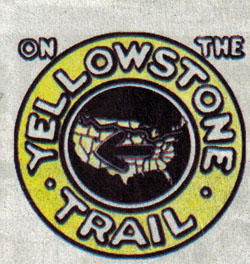The Yellowstone Trail: Our Past, Our FutureThe Thorp Courier (Thorp, WI) |
|
There was little government concern about cross-country roads, no federal Department of Transportation, and little government money for roads. Only a few states had highway departments, including Wisconsin. But, as automobile ownership increased, people began to demand roads to travel on with their new cars. So, private citizens formed groups to force counties to build roads and to make them join up with roads in counties on either side of them. One such group was the Yellowstone Trail Association, formed in 1912 in Ipswich, SD. In honor of the national park the association named their organization after; they selected yellow (of course) with a black arrow to mark a tourist route from coast to coast. They painted rocks, telephone poles, sides of buildings, and anything else with their yellow and black sign to make the route. The route was named the Yellowstone Trail in 1915 and runs from Plymouth Rock, MA, to Seattle, WA, snaking through Wisconsin from Kenosha to Hudson. In this area, the Trail runs mostly down what is now called County Road X. The Yellowstone Trail was very popular. Towns and individuals along the Trail paid annual dues in exchange for advertising in Yellowstone Association literature. The association also did many things to help the tourist. They gave out maps and folders with travel information. They had “Trailmen,” local men who acted to help tourists find the local campground or find the road to the next town. They also had Travel bureaus, much like the AAA does today. In 1918, Wisconsin became the first government anywhere to number its major routes. Several other states followed suit. In 1926, state representatives and federal government highway officials assigned U. S. highways numbers. Named highways were no longer needed, maps became common, and federal and state taxes supplanted “dues.” Citizen associations faded. Then, the Great Depression came, wiping out completely named road associations and their colored signs. However, because the Yellowstone Trail was so popular, it ws still referred to by name in many placed into the 1940’s. To this day, there are many, many streets and rural roads still bearing the name Yellowstone Trail. Today, there is a rebirth of interest in the Yellowstone Trail. Heritage tourism is the #1 reason for travel in Wisconsin and other states, says the Wisconsin Department of Tourism. Genealogy is a booming hobby. Museum attendance is up. Perhaps people are searching for a vision of a simpler past searching out information about important local history. As a result, communities and businesses today are beginning to realize the significance of the nostalgic Yellowstone Trail – and how it can be tapped for tourism dollars. Businesses are putting “On the Yellowstone Trail” on their letter-head. A new cheese factory in Cadott was named Yellowstone Cheese. The Stanley Republican newspaper in Stanley displays the Yellowstone Trail logo noticeably on their front page. A park in Thorp was named Yellowstone Park a few years ago. The proprietors of Taylor’s Do Drop Inn in Owen proudly call attention to the yellow “R” original Yellowstone Trail marker on the side of their establishment. The villages of Curtiss and Withee mention the Yellow-stone Trail on their signs greeting visitors to their respective communities. The Highway 29 Community Partnership has joined together these seven small communities from Cadott to Curtiss. The Partnership, interested in economic development, puts up road signs on their part of the Yellowstone Trail and uses it in their promotions. For 2008, the Partnership is organizing a second Trail Days (wherein area townsfolk join together in April and fix up the Trail and its markers), a seven-community Thrift Sale (“Sale-ing the Yellowstone Trail from C to C”) on May 16 & 17, and a Sociability Run (antique car caravan) on June 14 & 15. Just as the Trail was promoted by towns 100 years ago, so is the Trail being promoted today. For the Trail may be the area’s past, it is also its future. |
**This Clark Co., WI Internet Library, ALHN & AHGP website is dedicated to the free sharing of information by researchers, local historians, genealogists and educators. Because of our non-profit status, submissions are not to be used for profiteering of any kind. Our representatives cannot accept gratuities beyond the basic expenses (i.e. postage, copying, courthouse or rental fees) for obtaining requested information. We reserve the right to ban the involvement of anyone who intentionally disregards these policies. Please show your appreciation for this database by Becoming a Clark County History Buff or making a contribution to our Support Fund and Perpetual Preservation Account to help keep this Clark Co., WI database freely available on the World Wide Web and free from commercial enterprise.
*** This copyrighted Clark Co., Wis. genealogy and history material is used by permission of the submitters. Contact us if anyone is using this data inappropriately. It may not be copied and posted to any commercial/.com genealogy sites such as Genealogy Trails, Family Tree Maker or the merged companies Ancestry.Com/RootsWeb/MyFamily or sold for profit.
This page is a part of the Clark County, WI Internet Library Project
Every submission is protected by the Digital Millennium Copyright Act of 1998.
~~The Clark Co., Wisconsin History Buffs maintain these pages in support of Free On-line History & Genealogy~~
 It’s hard to believe, but highways did not always have numbers.
They had names. Some named roads were short, going from only one
town to another. Some ran between national parks and important
tourist attractions.
It’s hard to believe, but highways did not always have numbers.
They had names. Some named roads were short, going from only one
town to another. Some ran between national parks and important
tourist attractions.